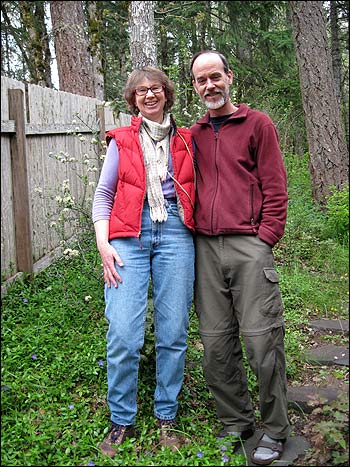
Woodland, Enriched
Going native in the south hills
By Rachel Foster
 |
Mother’s Day 2009 saw Eugene’s first formal tour of local gardens that feature native plants. The tour was organized by the Native Gardening Awareness Program (NGAP), a committee of the Emerald Chapter of the Native Plant Society of Oregon. It was very well attended. NGAP member and tour organizer Mieko Aoki estimated that many of the gardens received well over 500 visitors. On May 9 we will be treated to a second Mother’s Day Native Garden Tour covering nine gardens and featuring a variety of Willamette Valley habitat types. Two gardens, one public, one private, are making a return appearance. The other seven are new.
One of those new gardens sits on a steep, wooded hillside of native oaks and Douglas fir on Shasta View, in Eugene’s south hills. It belongs to Clay Gautier and Gail Baker, who have lived there since 1995. At first glance, the place looks like native woodland, until you realize that no natural woodland could be so rich in species in such a small area. Aside from a raised bed bordering the driveway, it is largely native. The owners have incorporated a number of non-native rhododendrons (which are on a drip irrigation system) and there are places where vigorous native geum is fighting it out with patches of non-native geranium. But as Clay like to say, “On the genus level we are very native!”
Although Gautier and Baker describe the yard as pretty much a weed patch when they acquired it, there were some natives present besides the trees, particularly herbaceous ones: camas, Oregon iris, fawn lily and spring beauty. There was little in the way of native shrubs, except for some baldhip rose, snowberry, madrone and honeysuckle (Lonicera hispida), which is trimmed close to the ground to prevent it climbing the trees. There was also poison oak, which the owners suppressed by repeated manual clipping. They’ve added quantities of evergreen huckleberry, salal, Oregon grape, and vine maple, as well as ocean spray, red flowering currant and two Pacific dogwoods.
There are also several shrubs you encounter less often, among them Viburnum edule; white flowered Ceonothus cuneatus, a species you can see growing on Mount Pisgah; and manzanita (Arctostaphylos columbiana), a little leggy from the shade. The owners have introduced many herbaceous plants, as well. Besides such stars as trillium (both species that are locally native) and houndstongue, there are less conspicuous things like star flower, miners lettuce and pathfinder, and two good groundcovers: strawberry (probably Fragaria vesca) and false lily of the valley (Maianthemum dilatatum).
Camas was blooming when I visited. Since the deer fence was built, it blooms well and has spread. Baker said Gautier (who does most of the gardening) helps it along by shaking the seed pods around. Gautier is no longer adding much, he says, and describes the gardening routine as “mostly a removal process.” Maintenance consists of trimming back plants that get out of scale, and lots of weeding, which he does mostly in early spring. A big component of that is keeping out woody invasives such as English laurel, English hawthorn and blackberry. When I asked if they did any leaf removal, Gautier said that on the contrary, he brings in more leaves! Nothing is fertilized except the rhododendrons.
Not surprisingly, the garden attracts wildlife: newts and frogs, garter snakes and alligator lizards, foxes, moles and squirrels. Gautier has even seen a bobcat. Bird visitors include: woodpeckers (downy and pileated,) juncos, nuthatches, grossbeaks, hummingbirds and the occasional tanager.
Not far from the garden on Shasta View, just off Spring Boulevard, is a novel addition for a garden tour: Crescent Ridge is a compact planned development of 10 houses clustered near the top of a 2.27 acre site, 50 percent of which is left undisturbed in native vegetation and existing trees. Runoffs from storm drains are designed to flow through the common area in a way to prevent erosion and minimize impact on the city storm water system. Individual home sites are landscaped with native plants.
The second Mother’s Day Native Garden Tour happens from noon to 5 pm Sunday, May 9. Check the NPSO website www.emerald.npsoregon.org for other locations on the tour, and print your own tour materials if you can. Should you feel inspired to do a little native gardening yourself, NGAP has produced a set of three booklets about gardening with native herbaceous plants, shrubs and trees. Download from the NPSO website or look for hard copies at Down to Earth and events where NPSO is present. NPSO has also prepared a list of nurseries in the southern Willamette Valley that carry native plants.
Rachel Foster of Eugene is a garden writer and consultant. She can be reached at rfoster@efn.org